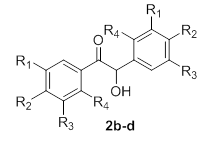
Synthesis of 4-hydroxy and 6-hydroxyindoles: a renaissance of the Bischler reaction
Abstract
In the present work we studied a modified Bischler-Möhlau reaction – synthesis of indoles from benzoin and aniline. Our proposed modification of this method differs from that described earlier in that the reaction is carried out at a lower temperature, which makes it possible to improve yields and reduce formation of tarry side products. In addition, unlike the previous contradictory works, which described the preparation of a single 4-hydroxy or 6-hydroxy isomer in condensation of m-aminophenol and benzoin, we obtained both 4-hydroxy and 6-hydroxy isomers.
Keywords
Full Text:
PDFReferences
Gunasekera SP, Kashman Y, Cross SS, Lui MS, Pomponi SA, Diaz MС. Topsentin, Bromotopsentin, and Dihydrodeoxybromotopsentin: Antiviral and Antitumor Bis(indoly1)imidazoles from Caribbean Deep-sea Sponges of the Family Halichondriidae. Structural and Synthetic Studies. Org. Chem. 1988;53:5446–5453. doi:10.1021/jo00258a009
Sakemi S, Sun HH. Nortopsentins A, B, and C. Cytotoxic and antifungal imidazolediylbis[indoles] from the sponge Spongosorites ruetzleri. Org. Chem. 1991;56(13):4304–4307. doi:10.1021/jo00013a044
Phife DW, Ramos, RA, Feng M, King I, Gunasekera SP, Wright A, Patel M, Pachter, JA. Marine Sponge Bis(indole) Alkaloids that displace ligand Binding to αl Adrenergic Receptors. Bioorg Med Chem Lett. 1996;6(17):2103–2106. doi:10.1016/0960-894X(96)00376-9
Shulgin A, Shulgin A, Tihkal: A Continuation Paperback, U.S.: Transform Press; 1997. 804 p.
Yoshimitsu Y, Yasuhiro K. Inhibitory Effects of Herbal Alkaloids on the Tumor Necrosis Factor-α and Nitric Oxide Production in Lipopolysaccharide-Stimulated RAW264 Macrophages. Chem. Pharm. Bull. 2011;59(3):388–391. doi:10.1248/cpb.59.388
Khan SI, Abourashed EA, Khan IA, Walker LA. Transport of Harman Alkaloids across Caco-2 Cell Monolayers. Chem. Pharm. Bull. 2004;52(4):394–397. doi:10.1248/cpb.52.394
Li Y, Sattler R, Yang EJ, Nunes A, Ayukawa Y, Akhtar S, Rothstein, JD. Harmine, a natural beta-carboline alkaloid, upreg ulates astroglial glutamate transporter expression. Neuropharmacology. 2010;60(7-8):1168–1175. doi:10.1016/j.neuropharm.2010.10.016
Nenaah G. Antibacterial and antifungal activities of (beta)-carboline alkaloids of Peganum harmala (L) seeds and their combination effects. Fitoterapia. 2010;81(7):779–782. doi:10.1016/j.fitote.2010.04.004
Gribble GW. Bischler Indole Synthesis. Indole Ring Synthesis. 2016;23:249–259. doi:10.1002/9781118695692.ch23
Orr H, Tomilson M. 4- and 6-Methoxy-2,3-diphenylindole. J. Chem. Soc. 1957:5097. doi:10.1039/JR9570000004
Teuber HJ, Schnee K. Zur Frage des Ringschlusses bei der Indolsynthese nach Bischler mit m-Aminophenol. Chemische Berichte, 1958, 91;(10):2089–2094. doi:10.1002/cber.19580911013
Ohta K, Hasebe H, Ema H, Moriya M, Fujimoto T, Yamamoto I. Discotic Liquid Crystals of Transition Metal Complexes 111: The First π-Acceptor in Discotic Columnar Liquid Crystals Obtained from Octasubstituted Bis(diphenylethane-1,2-dithiolene)nickel Complexes. Molecular Crystals and Liquid Crystals. 1991;208(1):21–32. doi:10.1080/00268949108233940
Richtzenhain H. Enzymatische Versuche zur Entstehung des Lignins, II. Mitteil.: Die Dehydrierung des 5-Methyl-pyrogallol-1.3-dimethyläthers. Berichte Der Deutschen Chemischen Gesellschaft (A and B Series). 1944;77(6-7):409–417. doi:10.1002/cber.19440770608
Singh P, Mittal A, Kaur S, Holzer W, Kumar S. 2,3-Diaryl-5-ethylsulfanylmethyltetrahydrofurans as a new class of COX-2 inhibitors and cytotoxic agents. Org. Biomol. Chem. 2008;6(15):2706. doi:10.1039/b803608
DOI: https://doi.org/10.15826/chimtech.2022.9.2.S2
Copyright (c) 2021 A.D. Sharapov, R.F. Fatykhov, I.A. Khalymbadzha, O.N. Chupakhin

This work is licensed under a Creative Commons Attribution 4.0 International License.
Chimica Techno Acta, 2014–2025
eISSN 2411-1414
Copyright Notice







